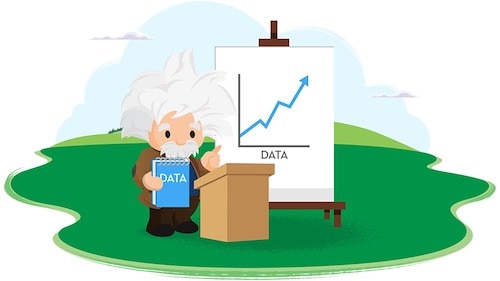Incorporating artificial Intelligence (AI) into marketing is how you deliver the connected and personalized experiences that customers expect. In fact, a whole 70% of customers say these kinds of experiences — seamless handoffs between departments and channels, and contextualized engagement based on earlier interactions — are very important to winning their business. It’s why a majority of customers (62%) now say they’re open to companies using AI to improve their experiences.
As more marketers and customers understand what’s possible with AI, we can only expect those numbers to grow. So, if you’re wondering how to use AI to personalize customer experiences, you’re in the right place.
Let’s break down how marketers can tap into the power of AI today.
How can marketers use AI?
As a marketer, you already have the data you need to create value. You just need to start with some targeted use cases. Here are three ways you can apply AI to your digital marketing:
- Use smart segmentation to identify your target audience
- Connect with your customers on their terms
- Deliver tailored content to each target audience segment
1. Use AI and smart segmentation to identify your target audience
Audience segmentation is an essential part of all marketing. After all, how are you going to market if you don’t know who you’re marketing to? In the past, marketers would set a goal by asking a question like: “Do we want more awareness, engagement, retention, revenue, or something else?” Then, they would manually estimate the best general audience for the campaign.
Now, AI and predictive analytics let marketers pinpoint the best audience more quickly and accurately, as well as find new audience segments that share similar attributes. This allows you to deliver more personalized offers to your customers, creating a unique one-to-one connection that would have hard without the scale of AI.
What does this look like in practice? An outdoor apparel retailer that segments its main audience as avid campers and hikers might discover a number of distinct personas within their audience using AI-powered segmentation. AI could allow them to uncover personas like “Glampers” who appreciate luxurious tents and creature comforts to “Trail Techies” who want the most innovative high-tech equipment. Now, the retailer can target these distinct personas with tailored campaigns to highlight an on-the-go coffee maker for Glampers and a new GPS watch for Trail Techies. Suddenly, your messages are more relevant and your customer connections are more meaningful.
AI can also analyze which actions your target audience segments are likely to take upon receiving your message. To start, it’s best to identify the concrete yes-or-no questions you want to answer. For example, if you send an email:
- Will the audience open it, or not?
- Will they click through, or not?
- Will they convert, or not?
- Will they unsubscribe, or not?
With answers to these questions, you can better customize messages. For a customer who doesn’t regularly engage with your emails, you can encourage them to update their communications preferences to only receive content they find valuable. And for a customer who often engages with your emails, a loyalty membership offer may be the perfect way to grow the relationship.
To recap, here are a few steps to leverage AI for smarter audience segmentation:
- Take stock of your main audience(s) — who they are and what they like
- Use AI to do deeper audience analysis to uncover new personas
- Treat new personas as sub-segments, and market to them personalized messages
2. Use AI to connect with your customers on their terms
More detailed audience segmentation is a great start, but as a marketer, you also need to deliver the right message, on the right channel, at the ideal time — whether that’s mobile, email, desktop or laptop, or social media. AI can help you identify the perfect messages, volume, and channels to keep your customers engaged.
By analyzing the number of messages you send to your customers against relative engagement rates, you can begin to paint a picture of how your audience prefers to interact with your content. For instance, some audiences just won’t engage with certain channels at all. AI can help you predict this, so someone who is unlikely to open an email can be reached with a social ad or mobile push message instead. The same can be done with send-time optimization to reach your customer when they’re most likely to pay attention.
To recap, here’s how AI can help you meet your customers where they are:
- Audit for what messages you send, when you send them, and on what channels
- Collect customer preferences on frequency, channel, and send time through your preference centers and using AI
- A/B and multivariate test to measure the impact of your AI-optimized campaigns versus your existing baseline
3. Use AI to deliver tailored content to your audience segments
Now that you’ve identified the right audience, when, and where to reach them, the next step is to create engaging content. You may have used content with special offers or creative elements that change based on specific customer attributes before. This is called dynamic content and it’s great but often manual and time-consuming to scale. But that’s changing with AI.
For companies that have thousands of products and hundreds of thousands of customers, AI can help scale curated product recommendations that would be relevant for each target customer segment. AI-powered product recommendations account for browsing behavior and product affinity in order to match customers with products they’re most likely to buy.
Beyond products, AI-powered campaigns can offer personalized banner ads that are more likely to prompt customers to action. As AI continues to learn more about an audience’s preferences, it can personalize the content or offers in a campaign dynamically. It’s as easy as creating dynamic fields on your website, mobile app, or email newsletter and watch AI fill in the right offer for each target audience segment.
To recap, here’s how to scale personalized content with AI:
- Create a variety of offers for your target audience segments
- Use rich tags or metadata to identify what audiences should be targeted with each offer
- Incorporate dynamic fields into your content linked to tags and metadata
- Automate with AI-powered recommendation engines and machine learning
AI in marketing is here to stay
As customer choice and connectivity continue to increase, customers’ demand for personalized experiences and marketers’ need for scale will only become more prevalent. That’s how we know AI is here to stay.
To stay ahead, marketers should think about how AI can help them with smarter audience segmentation, better engagement practices, and dynamic content strategy. These, and so much more, will soon become essential parts of any marketer’s toolkit.
To learn more about how our Einstein artificial intelligence solution helps marketers deliver value to customers, check out the “Einstein for Marketing Cloud Basics” module on Trailhead.
And if you still have questions, on how to apply AI to marketing, reach out to me on LinkedIn or Twitter, or sign up for the Salesforce Blog newsletter to receive the next installment of our “Ask Salesforce” series.




























